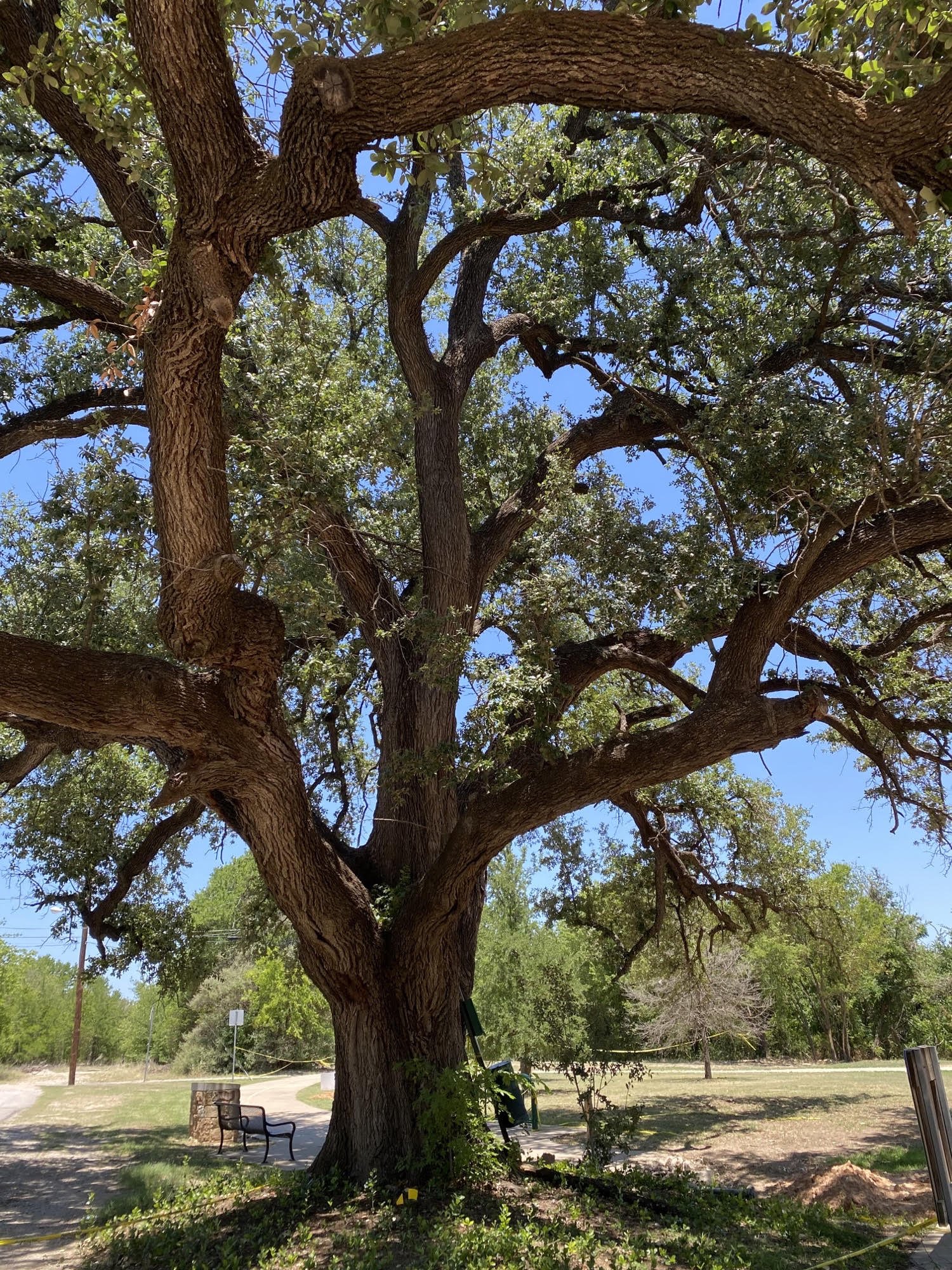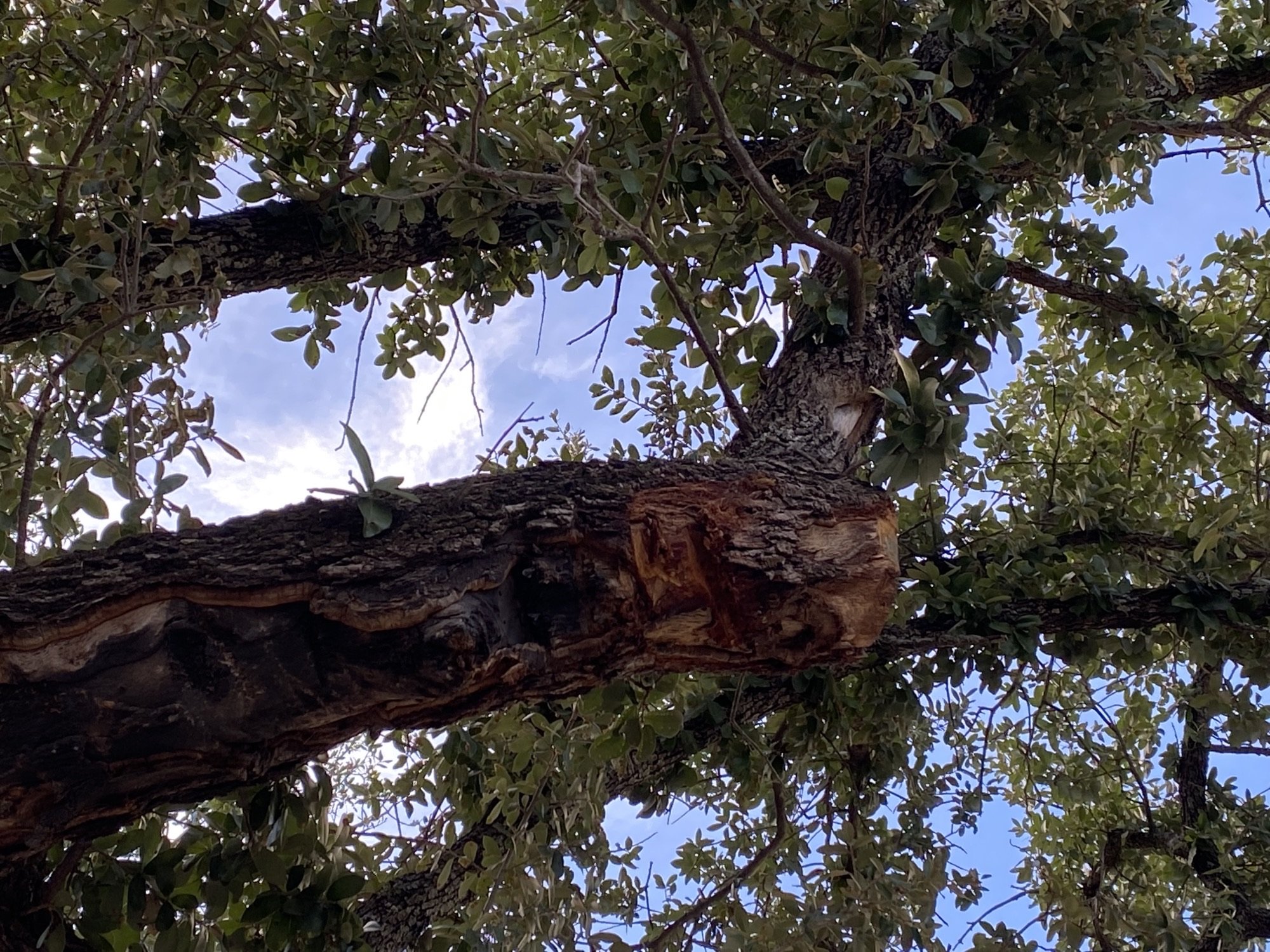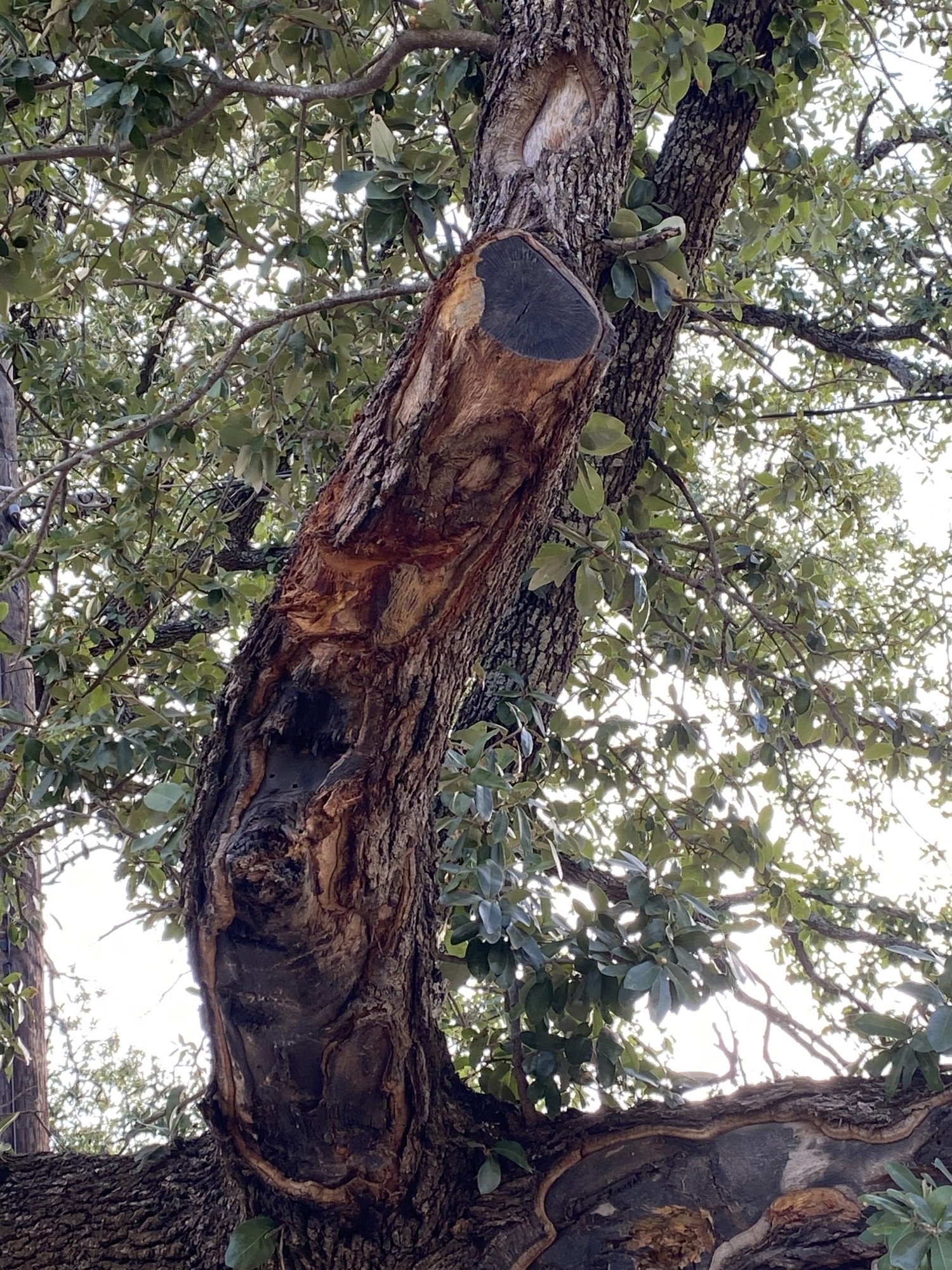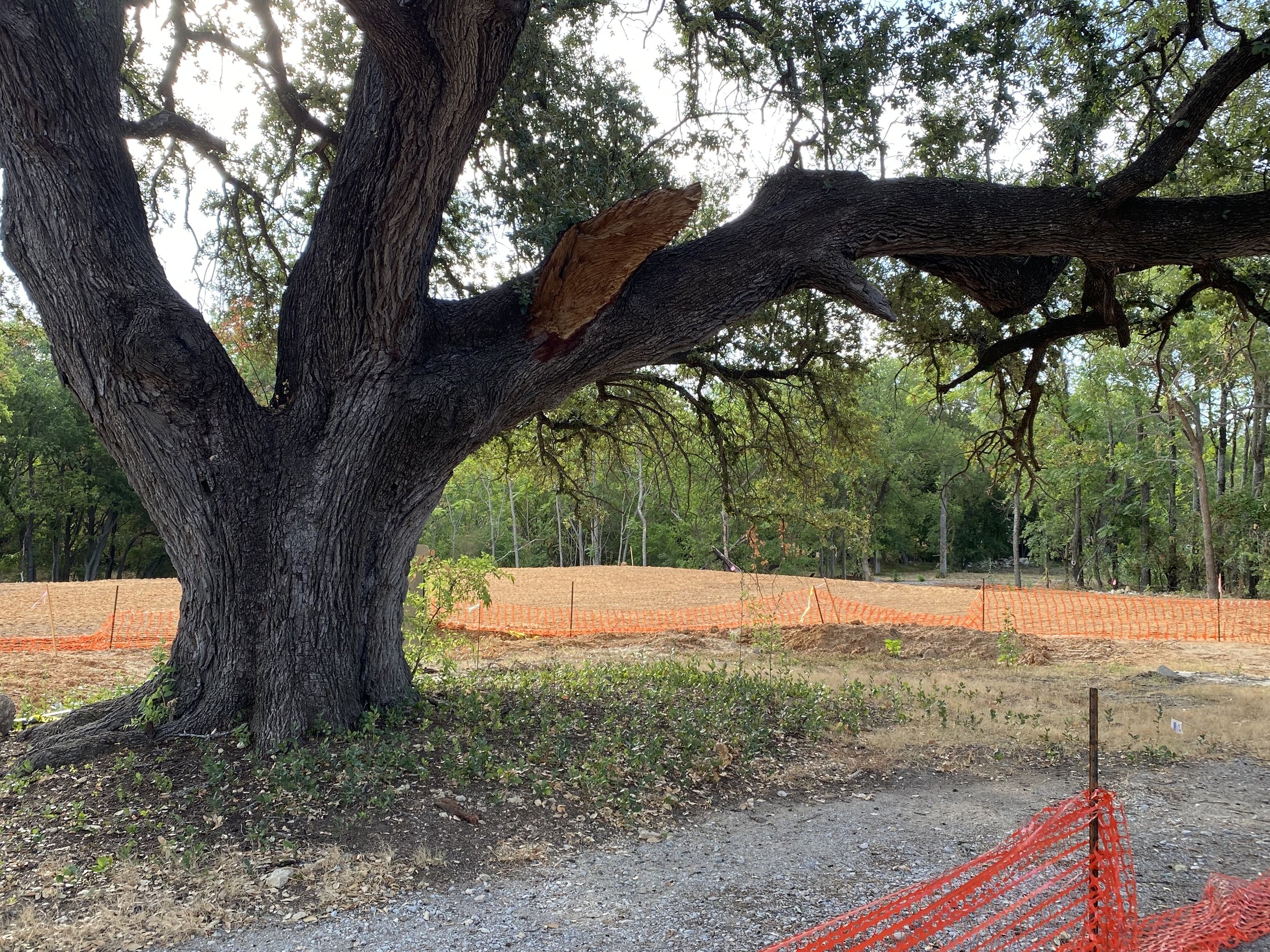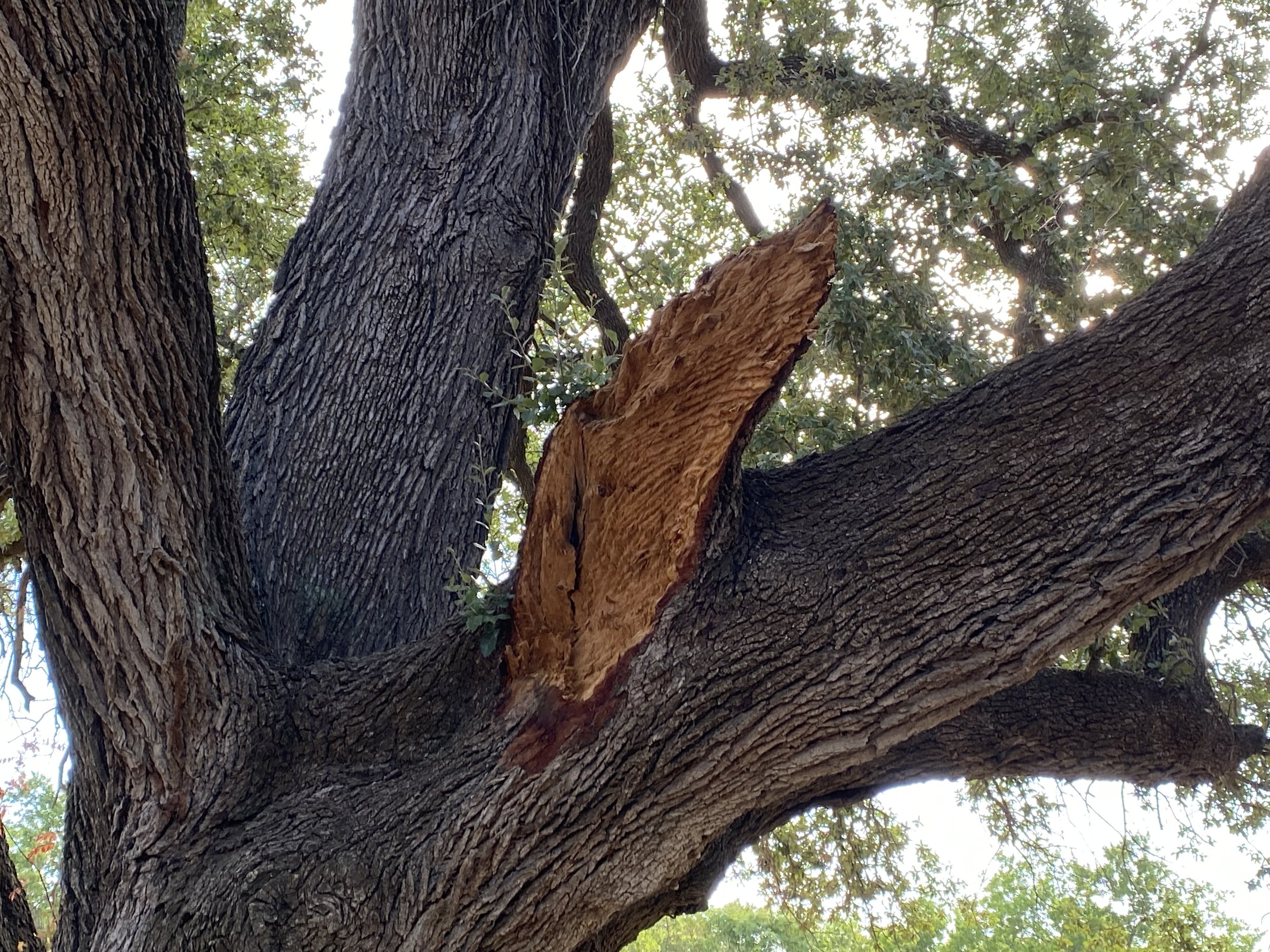Stephenville’s Once and Future Live Oak Tree
A brief history of the heritage live oak in Bosque Park on Vine Street, Stephenville, Texas
Draft for Discussion
Version 1.2
As of 3/8/23
Joe Carter
References:
https://chambermaster.blob.core.windows.net/userfiles/UserFiles/chambers/1545/CMS/Historical-Map-Stephenville-Side-with-locations.pdf
https://support.squarespace.com/hc/en-us/articles/206543407-Gallery-blocks
https://www.loc.gov/resource/wpalh3.34031804/?sp=1&st=image
https://docs.google.com/document/d/1sP8ffXwKlrt4igdzFo0KzZhcPwvXdx6OJAYGXsmFCAc/edit
log schoolhouse with split log benches: https://www.genealogy.com/forum/regional/states/topics/tx/52016/
The Senior Tree, Bosque Park, N. Vine Street, Stephenville, Tx - Circa 2013
This is a brief history of a Stephenville landmark - a magnificent live oak tree that sits in Bosque Park, a small city park on N. Vine Street in Stephenville, Texas. The tree rivals other officially-designated Historical or Heritage trees in the state of Texas. It is not yet officially designated as Historical or Heritage, but we hope to change that in the near future. It is a beautiful one-of-a-kind representative for the species - an asset that Stephenville is lucky to have in it’s city limits. It is likely one of the two oldest trees in Stephenville. It may be one of only 2 trees surviving in town from before 1854 when the first permanent white settlers arrived. It is the only pre-settlement tree on public property where it can be admired by the public at large.
Explorers coming through the area in the 1840’s described the Bosque River near the tree as having clear running water like a spring. That was because the thick trees and ground cover kept sediment from flowing into the river. When the settlers arrived in the 1850’s the trees were so thick it was said that a squirrel could travel from Stephenville 15 miles to Dublin without ever setting foot on the ground. [Cite Dan Young’s Blog here]
In 1854 there were thousands of trees in the area, giving the Bosque River it’s name. Bosque means “woods or forest” in Spanish. Today this tree is one of maybe 2 trees that remain from those thousands and thousands of trees that lived on the river in 1854. With few exceptions, the trees we see in Stephenville today are new growth that post-dates the arrival of white settlers. There are some large trees up and down the river but none appear to be this large. The oldest appear to be in the 100 to 150 year old range, having grown naturally or having been planted after the early onslaught of the settlers harvesting wood for timber and fuel, and clearing the land for crops and grazing.
The tree’s trunk is almost 17 feet around and over 5 feet across. It’s shade canopy stretches over 100 feet. It has an excellent balance of symmetry and variety in the way its limbs are arranged in the canopy. An arborist estimates its age as anywhere from 250 to 400 years old.
Live Oak Sapling
How The Senior Tree might have looked
in 1776 if it’s 250 Years Old, or
in 1620 if it’s 400 Years Old
Depending on which end of the age range you pick, it might have looked like the live oak sapling pictured above. This photo shows what the tree might have looked like either when the Pilgrims landed at Plymouth Rock about 400 years ago in 1620 or when the Declaration of Independence was signed in 1776 around 250 years ago. We won’t know it’s age for sure until we’ve been able to measure it each year for several years to determine its actual growth rate. Once we know the growth rate for this specific tree, we can extrapolate back to determine its most likely birthdate. For now, even the most conservative 250 year age estimate makes it a very special tree.
20 inch Live Oak -
The Seniors Tree might have been this size in 1854, but much more beautiful than this one.
It was definitely a large mature shade tree in 1854, when John Stephen and Major George Erath arrived in what is now Stephenville. If it’s around 250 years old now, it would have been around 80 years old in 1854. An 80 year old live oak might have had a diameter of around 18 to 24 inches like the one pictured above. It was nowhere near the 64 inch tree it is now, but it was definitely a large mature shade tree in 1854.
So let’s look at some history for what was going on around The Senior Tree in 1854. I’m going to talk about some history of things that happened and also some history of things we know for sure didn’t happen. In studying history, it’s often more important to know what didn’t happen as it is to know what did happen.
The document pictured above is a typewritten manuscript stored in the Library of Congress. It was created in 1936 by Mrs. Mary McNeill Faye who was documenting an interview with Mr. William V. Ervin. I’m assuming that Mrs. Faye was a descendant of Dr. W.W. McNeill, a young physician who was among the first arrivals. We haven’t yet found any biographical information on Mr. Ervin. 1936 was 82 years after 1854 so he could have been a child in the early settlement.
The manuscript says,
Dr. W. W. McNeill, a young physician; Major George B. Erath and John M. Stephen, came into the frontier country in search of a good location for their homes, in the spring of 1854. On the spot where the town of Stephenville, county seat of Erath County now stands they found what they were looking for in the way of tillable land with plenty of grass, water and game, located there.
Major Erath and John M. Stephen surveyed the land into farms, and laid off the town-site of the present city of Stephenville.
For some more details about the survey activity described above, we have the following passage from the City of Stephenville website:
From the stephenvilletx.gov website
The passage reads:
“In laying out the town of Stephenville in July of 1855, two original streets were named - Floral and Green, with the square in the middle. Therefore, Floral which runs alongside the Dinner Bell and Green, which runs alongside the First Baptist Church marked the boundaries of the new township.” …
“It [Stephenville] would also be recognized for its thickly wooded area … In fact, so dense were the trees, that the name Bosque was given to the river, which means “woods” in Spanish”
So according to this passage from the Stephenville city government website, one of the first things that the surveyor Major George Erath and John Stephen did was lay out two streets, Floral and Vine as the north and east boundaries of the settlement. The other important fact this passage establishes is that there were a lot of trees in the area, so much so that the Spanish had named the nearby river Bosque which means woods. So Floral and Vine were the first 2 streets and there were a lot of trees in the area. They were probably especially thick along the river.
Let’s use a map to make that the information from these passages a bit more visual. Following is a high level map of downtown Stephenville created by the Stephenville Study Club. We’ve augmented it with some additional notations to show how it relates to The Senior Tree.
Stephenville Study Club Historical Interest Map with additions
https://chambermaster.blob.core.windows.net/userfiles/UserFiles/chambers/1545/CMS/Historical-Map-Stephenville-Side-with-locations.pdf
In the Study Club map, we’ve highlighted Floral Street and Green Street in blue. We’ve added item 13 for the location of The Senior Tree in Bosque Park. As you can see, the tree is one block from the intersection of Floral and Vine, the first 2 streets laid out in the town plat. It’s near the Bosque or “Woods” River, so in 1855, it was probably surrounded by a lot of other trees.
Now let’s look at some more historical records to find out what else was going on around that time in addition to surveying and laying out the town plat.
from Mary McNeill Faye Transcript, 1936, Library of Congress
https://www.loc.gov/resource/wpalh3.34031804/?sp=1&st=image
The passage reads:
“The men built log cabins after their selection of the site for their settlement in 1854, and in the fall of that year moved their families there. Lumber for the erection of a store, post-office and union church was brought by ox-wagon from Waco.”
So the men arrived in the spring of 1854. They worked through the summer building log cabins and by that fall, they sent for their families. There were 30 families in the initial group, so that’s 30 log cabins. They carted in lumber for the store, post office and church from Waco, but the log cabins would have been made from locally cut trees.
Let’s go back to our historical map. and recap
From Spring to Fall of 1854, the men were busy building 30 log cabins from local timber near the vicinity of Floral and Greene. One block west of Floral street, there was this really nice large 18 to 24 inch live oak tree and they chose to not cut it down? If for some reason it wasn’t suitable for cabin walls, it would have made a really nice bench when split in two. Or it could have fueled their cooking fires. But for some reason they cut down thousands of other trees nearby and left this one standing. Can you think of reasons why they might have left it unharmed?
The preservation of the tree in the early settlement for reasons unknown is a pattern that occurs over and over. Below we discuss other things going on in the early settlement that could have affected the tree but didn’t.
Some time in the 1850’s the first schoolhouse was erected 1 block west of the courthouse. They carted milled cedar from Waco for the structure, but the seating for the school was split log benches from local timber. [Need reference] The Senior Tree less than a half mile away and it would have been an excellent choice for these benches, but it was spared.
The historical Beech House is slightly more than a block from the Senior Tree. It was built as early as 1857 by the Inadeeb (spelling?) family. By 1873 it was owned by it’s namesake James Beech. Mr. Beech was quite industrious. He owned a saloon downtown and a cotton gin, flour mill, and sawmill southeast of town. So every day, Mr. Beech walked or road within sight of the tree. Even though he owned a sawmill, for some reason he didn’t find it necessary to turn the tree into lumber.
https://atlas.thc.state.tx.us/NR/pdfs/100002349/100002349.pdf page 55
There was another sawmill on Long Street on the east side of the river. The Drue sawmill. It was said to have provided prodigious amounts of oak and cedar lumber for the the growing town. Any tree along the river upstream from the sawmill would have been easy pickings. With no upstream dams to store runoff, the river would have had a strong flow, allowing trees to be floated down to the sawmill. Even though the Senior Tree was in the Bosque floodplain less than 1/2 mile away from the saw mill, the mills lumberjacks and loggers choose to leave the tree standing.
Before and during the Civil War there were many African American slaves in the area. After the war, they were freed, but there was little work for them. They are said to have survived by cutting firewood and fence rails. Here’s what split rail fencing looks like:
Split-rail fencing is made by splitting tree trunks and large limbs into long strips known as rails using axes and wedges hammered into the wood. The Senior Trees main trunk is too short for rails, but it has lateral branches 20 or 30 feet long. These would have made great fence rails or firewood, but the freed slaves chose to let it stand, even though they were barely subsisting in the only line or work available to them.
From as early as the 1940’s perhaps earlier, the part of town near the tree was the African American section of town. The Cornelia Graves Schoolhouse, named after the renowned teacher of African American Children still stands behind the Beech House a little over a block away from the tree. The African American citizens of Stephenville were evidently good stewards of the tree in their neighborhood for decades. Perhaps they valued its shade for picnics. With its many low branches running parallel to the ground, it would have been a great climbing tree for their children.
Fast forward from the 50’s 60’s 70’s and 80’s to present day. in ?2013? The Bosque River Trail was installed and it passed directly beneath the canopy of the tree. A bench was placed in the tree’s shade so walkers and joggers could rest there and appreciate the tree. Hundreds of users pass by the tree each week now.
The Senior Tree on Bosque River Trail Circa 2013
Photo Credit: Google Maps Street View
After 165+ years of evidently good stewardship of The Senior Tree through thick and thin in spite of all the good reasons that people might have wanted to take it down, it still stands. More recent history has not been good to the tree for no reason whatsoever other than carelessness and ignorance.
The damage pictured in the photo below was caused by an electrical utility truck around 2016. There’s plenty of room to drive around the limbs overhanging Vine Street by bearing to the west side of the street, but this driver just barrelled right into this large limb. There is a city ordinance against damaging trees on City property. The City knows who caused this damage, but as far as we know no one has been fined for it.
Electric Utility Truck Damage - Circa 2016
In 2021, a city contractor garbage truck knocked out a huge limb as shown below:
City Contractor Garbage Truck Damage Circa 2021
City Contractor Garbage Truck Damage Circa 2021
Again, the City knows who caused the damage, but no one has been fined as far as we know. This type of damage is especially harmful to live oak trees because it exposes them to oak wilt disease. The wasps that carry oak wilt fungus from tree to tree are attracted to the sap from open wounds in trees. This damage should have been dressed and treated promptly by an arborist but it was left unattended by the City.
Example of oak wilt damage occurring near Stephenville.
Fast forward to the present. On May 3, 2022, the riparian greenbelt just south of the tree looked like the following picture
Ground cover and riparian green belt south of the tree on May 3, 2022
Photo Credit: Google Maps Street View
On May 4, 2022 dozers showed up unannouced and dozed the green belt south of the tree, taking with it the groundcover and a large portion of the tree’s roots that sit near the ground surface throughout the green belt.
Same view as above after the green belt near the tree was bulldozed.
in the following days, 120 truckloads of fill-dirt (1440 Cubic Yards) were dumped on the tree’s root zone up to several feet deep in places
The Senior Tree with fill dirt piled near its base.
Overhead shot of fill dirt leveled around the tree’s base.
The following diagram shows the Critical Root Zone (CRZ) for a 20 inch tree. Guidelines for construction around a tree are as follows:
No disturbance whatsoever of the soil around the tree in the 1/4 CRZ.
No more than 4 inches of added soil or 4 inches of excavation within the 1/2 CRZ
No more than 50% of the full CRZ is to be disturbed
[Need to provide a reference for the source of this diagram. May be City of Austin guidelines.]
Critical Root Zone calculations for the Senior Tree
Full root zone is diameter in inches X 1.5 X 1 foot. For The Senior Tree, it’s 96 feet
Critical root zone is diameter in inches X 1 foot. For The Senior Tree, it 64 feet
!/2 CRZ is 32 feet
!/4 CRZ 16 feet
Note: All measurements are from the base of the tree, not from the center.
[Need to add description of CRZ guideline violations that have been/will be created by planned Senior Center construction at the base of the Senior Tree]
The planned construction at the base of The Senior Tree in 2022 is in gross violation of the CRZ guidelines. These violations have already resulted in harm to the tree as illustrated in the photo below. Continuing the construction activity will likely result in the death of the tree over a period of months.
Recent die back in The Senior Tree’s canopy due to stress
Contrast the picture above with the following pictures of a healthy live oak tree that is approximately the same vintage as The Senior Tree. The pictures below show Baldy’s Tree, a large live oak on Hwy 108 south of Oakdale in Erath County. As far as we been able to determine so far, Baldy’s Tree, The Senior Tree and another specimen on East Road in Stephenville are the only remaining trees in Erath county that pre-date 1854. In contrast to The Senior Tree, Baldy’s Tree shows how magnificent these trees can be when the tree’s owner takes good of them.
Baldy’s Tree on Hwy 108 south of Oakdale. These pictures provide an example of healthy, well-cared -for live oak tree around the same age as The Stephenville Senior Tree.
Baldy’s Tree, Hwy 108 south of Oakdale, Texas
Baldy’s tree canopy - showing what a healthy live oak tree canopy looks like - bright green shiny leaves with few or no dead branches

